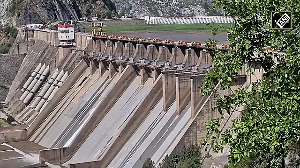While the tax collection figures indicate a negative impact of the global crisis on the overall fiscal situation, the moot point is how grim is India's position vis-a-vis other economies. Tax collections during the UPA regime point towards an accelerated and unprecedented growth. However, the regime shall also witness deteriorating finances with an unexpected bubble squeeze.
Tax collections so far are pointing towards the government missing on the gross tax revenue target for the first time in several years, primarily due to a continuous decline in excise, custom and advance tax payments. Contrary to this, the service tax collections have grown, though at a slower than anticipated rate. This is bound to challenge the government's ability to meet the revised gross tax revenue target of Rs 6,279 billion for fiscal 2009.
All eyes are now on the direct tax collections in the last 10 days of the year.
Finance ministry officials are optimistic and believe the collections are expected to improve due to TDS collections and the March 15 advance tax deadline defaulters who would make it up by end of this fiscal. Direct tax collections for the first 11 months have been 76.37 per cent of the total estimate. Statutory provisions, coupled with practical experience, suggest that corporates and non-corporates pay 25-40 per cent respectively of their tax liability in last week of March.
Advance tax figures are clearly suggestive of the trend that most Indian companies expect lower profits due to the impact of the slowdown. Sector wide differences are an indication of the severity of the crisis impacting different segments of the economy. Banking, insurance and consumer product companies have emerged clear leaders and are the highest contributors to the exchequer.
Regarding indirect tax collections, the target was revised down initially to fight inflation and boost demand. There has been a 6 per cent decline in excise collections, customs duty has increased 1 per cent (as against 3.7 per cent) and service tax collections rose 22 per cent (as against 27 per cent). It is unrealistic to expect the gap to be bridged by the end of the fiscal.
The money expended by the government on populist schemes, farmer loan waivers and the sixth pay commission has strained fiscal correction targets, pushing the revenue deficit to 4.4 per cent as against an estimated 1 per cent. The toll of the meltdown is (re)shaping global economies in different ways. India seems to be better placed than other economies that have been experiencing a sharp decline in tax collections and an even worsening fiscal deficit.
The impact of the meltdown on tax collections can be measured using a correlation analysis between GDP growth, fiscal deficit and tax collection trends. The Indian economy grew at 5.3 per cent in the third quarter of 2008 compared to a 7.8 per cent growth in the first half, suggesting higher GDP growth rates can control fiscal deficit, at a given level of government expenditure. Our challenge would be to achieve moderate growth rates with low fiscal deficit in the next fiscal. Having said that, the higher base effect of tax revenues seems to be a good cushion. Further, with a demand boost, the indirect tax rates for excise and service tax would be pushed up, either by later part of 2009-2010 or in 2010-2011.
India's unique composition of growth contributors cyclical fluctuations can be evaluated as the impact on sectoral composition of the economy. Agriculture will continue to drag the fiscal situation in the years ahead unless serious reforms are pursued. It's time the government realises the growth potential of food, agro and allied sectors which comes within the taxation net.
The industrial segment, on the other hand, has experienced a steady growth rate barring the last two quarters. However, the worrying factor continues to be short term deceleration which would adversely impact tax collections. The services sector is probably the saving grace. We, however, ought to wait and watch the impact on tax collections given a shift from three years of double digit growth.
In conclusion, the need for an accelerated pace of tax reforms was never felt as much as in the present downturn. Though indirect tax breaks will boost demand in the short term, only deeper reforms will aid improved compliance and push tax collections in the medium to long term.
The author is a partner with BMR Advisors and views expressed are personal.








 © 2025
© 2025